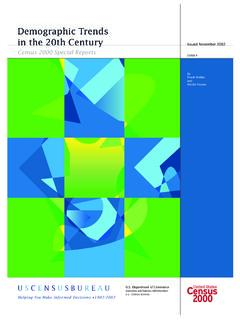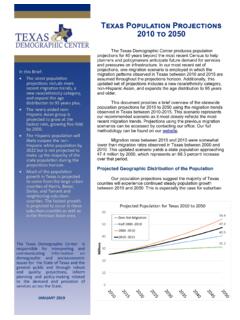Transcription of 27 May 2021 National Statistics Headline Statistics - GOV.UK
1 Responsible statistician: Ivan Bishop Email: Media enquiries: 020 7215 1000 Public enquiries: 020 7215 5000 Next publication: May 202 Trade Union Membership, UK 1995-2020: Statistical Bulletin 27 May 2021 National Statistics Headline Statistics The proportion of UK employees who were trade union members rose slightly to in 2020 up from a year earlier, and from the low of in 2017. The rise in the percentage of UK employees who were trade union members since 2017 has been driven by female membership, at in 2020 up from in 2019 and the low of in 2017. The proportion of male employees who were union members rose slightly on the year to in 2020, from in 2019, but remained lower than in 2017 ( ). The number of employees in the UK who were trade union members rose by 118,000 on the year to million in 2020.
2 Trade union membership levels among employees have now risen for four consecutive years following the fall to a low of million in 2016. However, the Office for National Statistics has warned that due to the Labour Force Survey (LFS) being weighted to pre-Covid-19 population projections, levels and changes in levels estimated from the LFS for 2020 should be treated with caution. Public and Private Sectors The rise in trade union numbers among employees was driven by the increase in public sector members, up 228,000 on the year to million in 2020. There was a significant fall in trade union membership numbers among private sector employees of 110,000 to million in 2020, one of the lowest levels private sector trade union membership has been since the series began in 1995, and the lowest since those of 2010 and 2011.
3 Characteristics Around half of employees who were trade union members had been working for the same employer for 10 years or more, compared to 31% of employees overall. Around three quarters (75%) of employees who were trade union members were aged 35 or over, compared to 63% of employees overall. Nations and regions The proportion of employees who were trade union members rose on the year to 2020 in England, up percentage points to , and Wales up percentage points to In contrast membership density among employees fell by percentage points to in Scotland and by percentage points to in Northern Ireland. Trade Union Membership Statistics , UK 1995-2020 2 Contents Headline Statistics _____ 1 Public and Private Sectors _____ 1 Characteristics _____ 1 Nations and regions _____ 1 Introduction _____ 3 Long term and recent trends _____ 5 Public and Private Sectors _____ 14 Personal and job characteristics _____ 17 Country and Regional trends _____ 19 Accompanying tables _____ 24 Technical information _____ 26 Concepts and definitions _____ 33 Further information _____ 34 Future updates to these Statistics _____ 34 Related Statistics _____ 35 Revisions policy _____ 35 Uses of these Statistics _____ 35 User engagement _____ 35 National Statistics designation _____ 36 Pre-release access to Statistics _____ 36 Contact _____ 36 Trade Union
4 Membership Statistics , UK 1995-2020 3 Introduction The Department for Business, Energy and Industrial Strategy is responsible for publishing the National Statistics on trade union membership. The Statistics are published on an annual basis. An annual question on trade union membership was introduced into the Labour Force Survey (LFS) in 1989 and it has been asked in the fourth quarter (Q4) every year since 1992. Questions on trade union presence were added in 1993, and the question on collective agreements between an employer and a trade union was introduced in 1996. The LFS trade union questions have United Kingdom coverage from 1995 onwards. The publication primarily produces UK Statistics for the period 1995 to 2020, with some Headline Great Britain Statistics going back to 1989.
5 The bulletin primarily reports Statistics on trade union membership among employees estimated from the Labour Force Survey (LFS). It also reports on: Trade union membership among those in employment, from the LFS (tables , ) Trade union presence in the workplace, from the LFS (tables , and ) Whether employee s pay and terms and conditions are directly affected by agreements between the employer and a trade union (tables , , and ) Administrative Statistics on trade union membership collected by government (table ) Official government Statistics on trade union membership have been collected on a regular basis since 1892 from administrative records. Coverage of the data relates to unions scheduled or listed in Great Britain but will include union members from outside the UK as well as union members not in employment.
6 The Statistics provide a record of collective representation of employees in the UK workforce and how it has changed over time. The information is mainly reported as the proportion of employees that were trade union members (trade union membership density), but some data on membership numbers is included. These estimates are also presented by age, gender, ethnicity, income, major occupation, industry, full and part-time employment, sector, nation, and region. The data reported in this bulletin are published in the accompanying spreadsheets. About Labour Market Analysis Labour Market Analysis is a multi-disciplinary team of economists, social researchers and statisticians based in the Labour Market Directorate of the Department for Business, Energy and Industrial Strategy.
7 Members of the team are responsible for producing this bulletin. Conventions The Statistics presented in this bulletin are based on fourth quarter estimates (October to December) from the Labour Force Survey unless otherwise specified. Members of the armed Trade Union Membership Statistics , UK 1995-2020 4 forces are excluded from analysis. All tables and charts relate to employees ( population aged 16 or over in paid employment) or those in employment in the United Kingdom with the exception of those specified in Chapter 1 (Long Term trends ). More detailed information on the concepts, methods, and quality of data used in this bulletin is available in the technical information and concepts and definitions sections. Symbols The following symbols are used in the accompanying tables: * sample size too small for a reliable estimate - data not available Weighting This publication uses the latest available Labour Force Survey weights for each year for its Statistics .
8 For the datasets for the years 2011 to 2020, the latest available weights are the 2018 weights. The ONS published an article which describes the new LFS weighting methodology (more robust data on migration), which will be applied to results from July 2021. In the article the ONS estimated that with the new weighting the unemployment rate would have been percentage points higher than the current weightings gave for October to December 2020. However, rates published from the LFS remain robust; but figures regarding levels and changes in levels should be used with caution. Covid-19 The ONS has stated that due to the impact of Covid-19, the LFS has been affected due to the weighting of LFS responses to official 2018-based population projections on demographic trends that pre-date the pandemic.
9 The ONS states in its latest (May 2021) Labour Market Statistics that the rates published from the LFS for 2020 onwards remain robust. However, levels and changes in levels should be treated with caution. ONS specifies that this issue will particularly affect estimates for ethnicity, disability, country of birth and nationality. Trade Union Membership Statistics , UK 1995-2020 5 Long term and recent trends In the data tables accompanying this publication, table shows the long-term administrative data, table shows UK employee union membership levels and table shows UK employee union density levels. Trade union employee membership levels substantially recovered from 2016 fall UK trade union membership levels among employees have risen in each of the past four years (by 17,000 in 2017, 103,000 in 2018, 91,000 in 2019 and 118,000 in 2020) to reach million in 2020.
10 Employee membership levels have therefore fully recovered from the large drop of 267,000 in the year to 2016 when membership levels among employees fell to a record low of million. Note that ONS has stated that levels estimates for 2020 should be treated with caution. The proportion of employees that were union members has also increased more substantially this year, with an increase of percentage points compared to the percentage point increases of the two prior years. The proportion of employees that were union members reached in 2020. This indicates that in the past three years growth in employees that were union members has been faster than growth in employee numbers overall. Union membership has declined in the past four decades, though the decline has slowed Trade union membership levels as reported by the unions listed or scheduled in Great Britain reached their peak in 1979 ( million) and declined sharply through the 1980s and early 1990s.


















